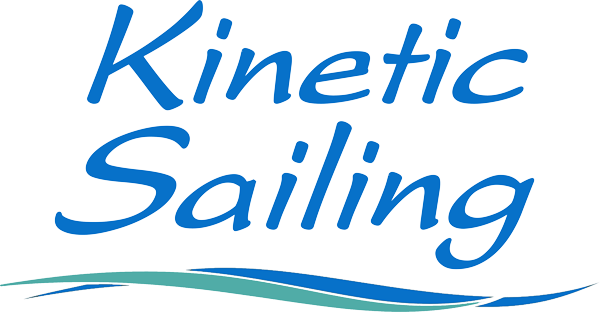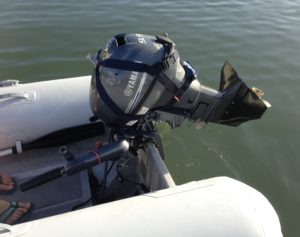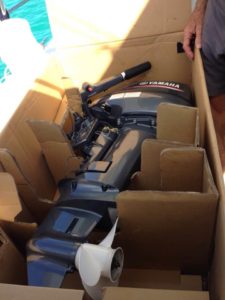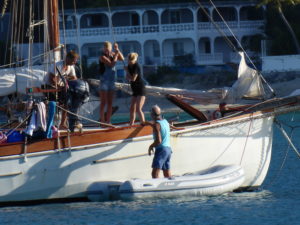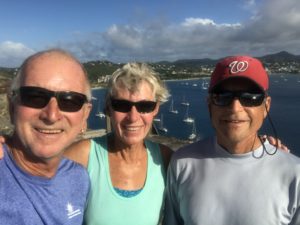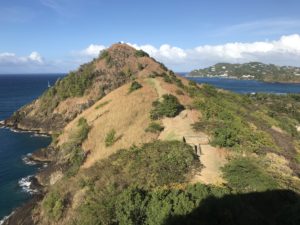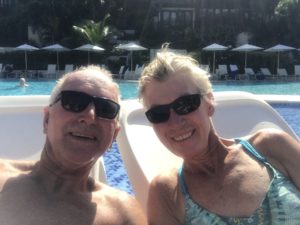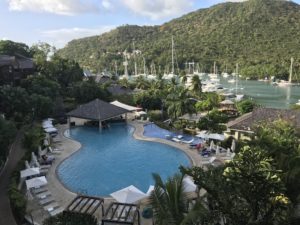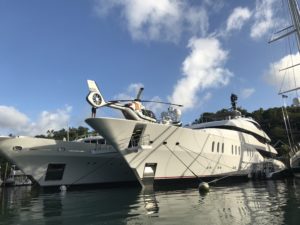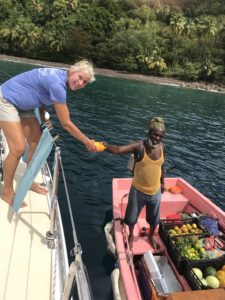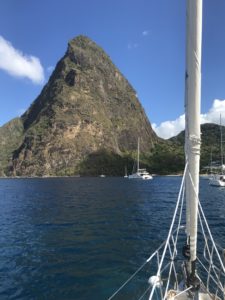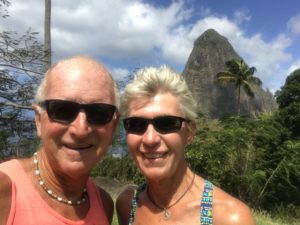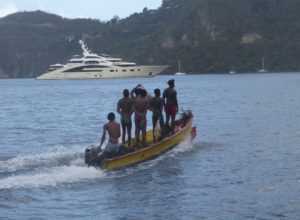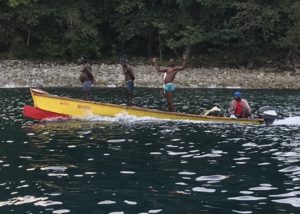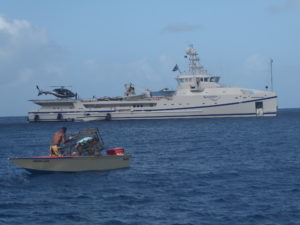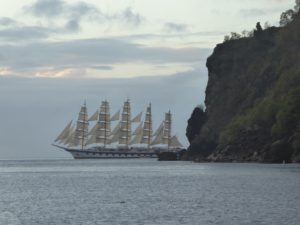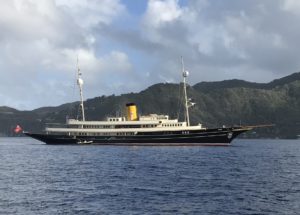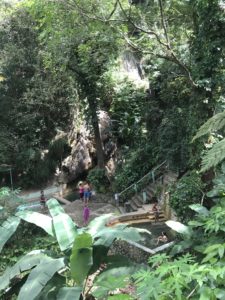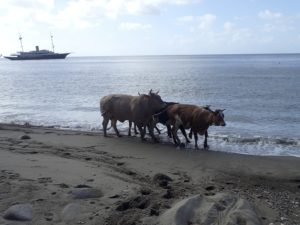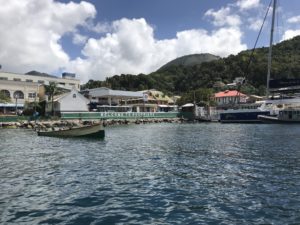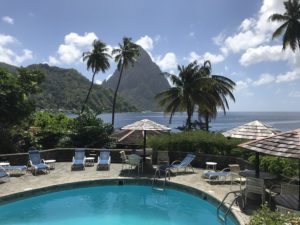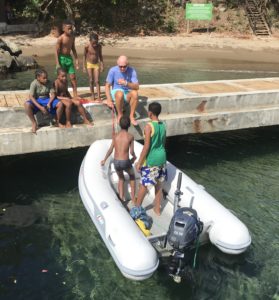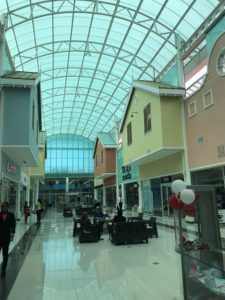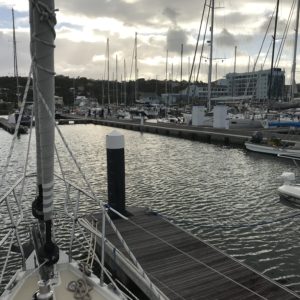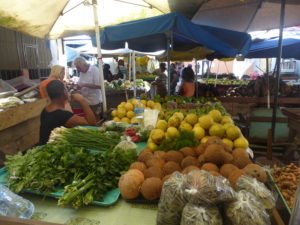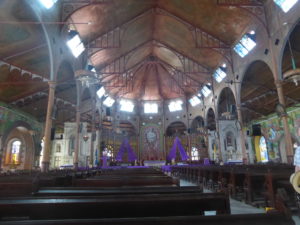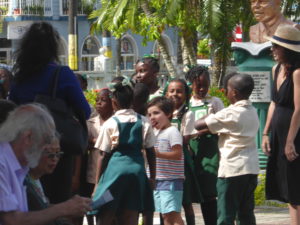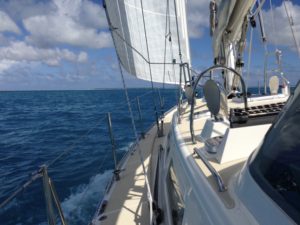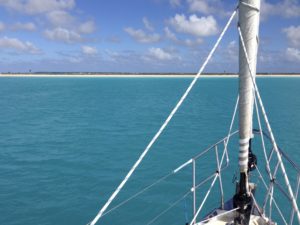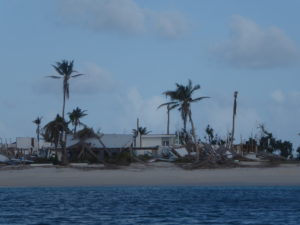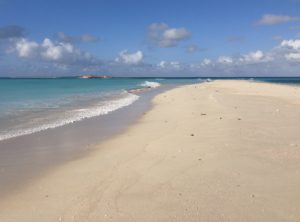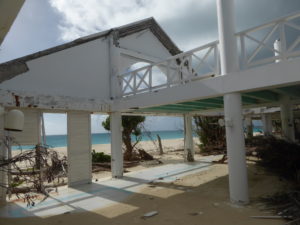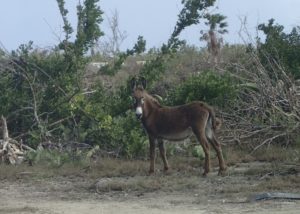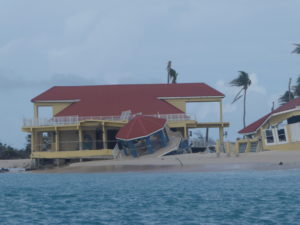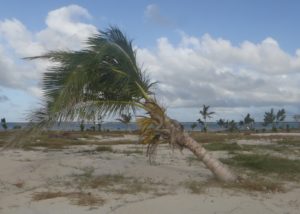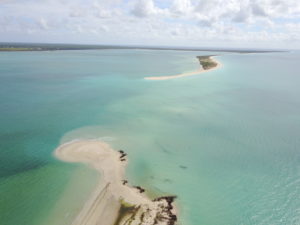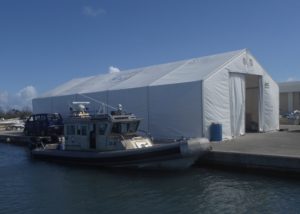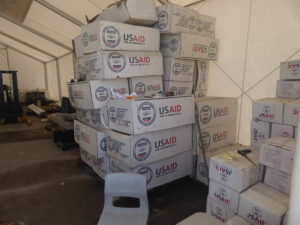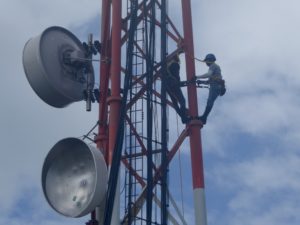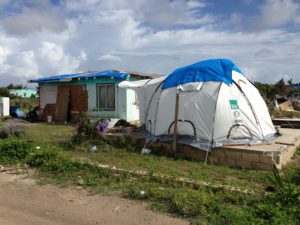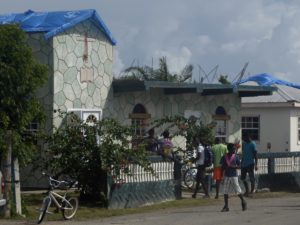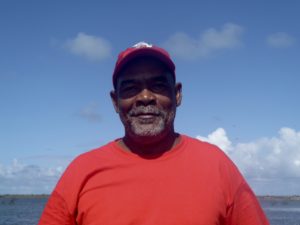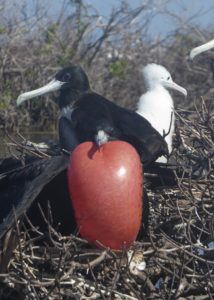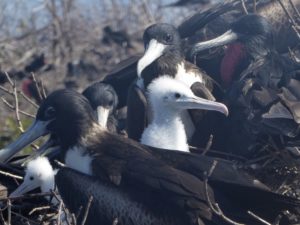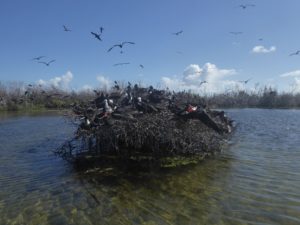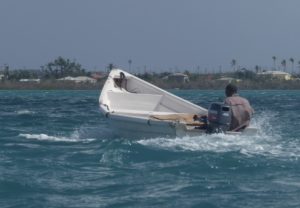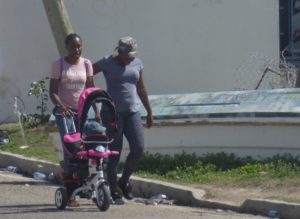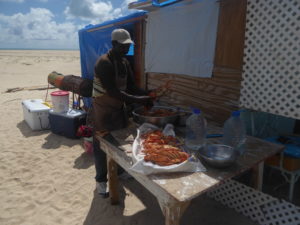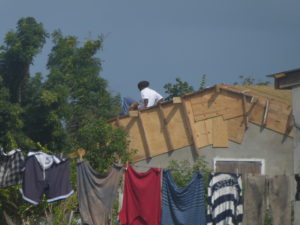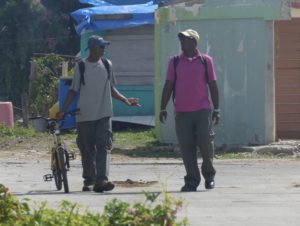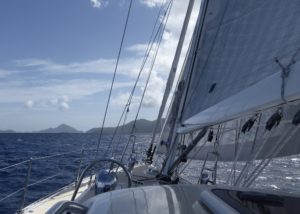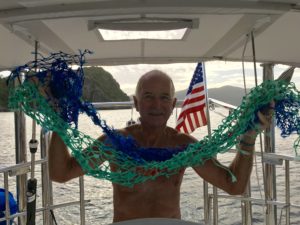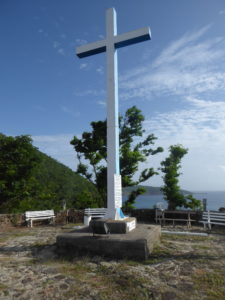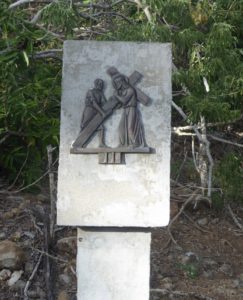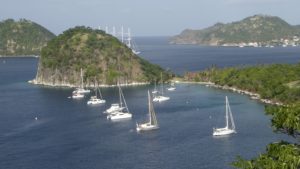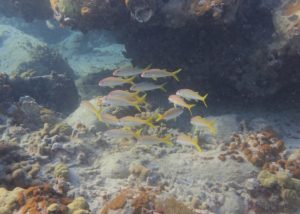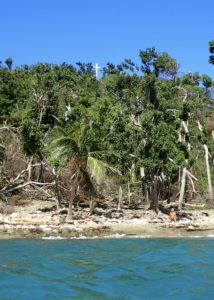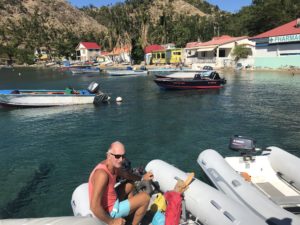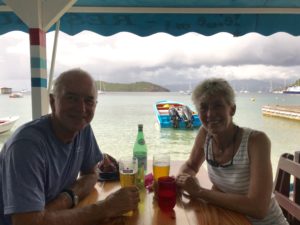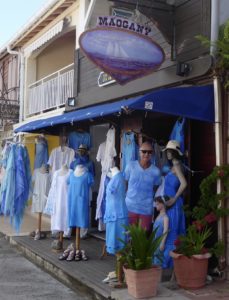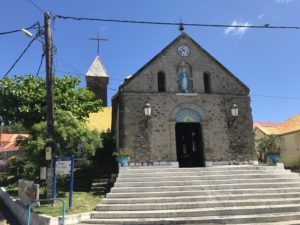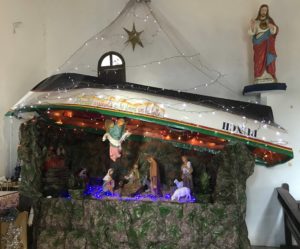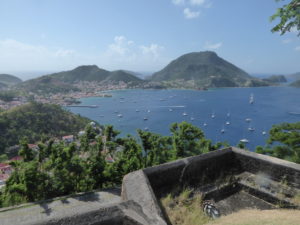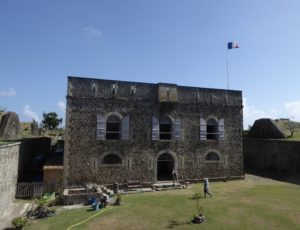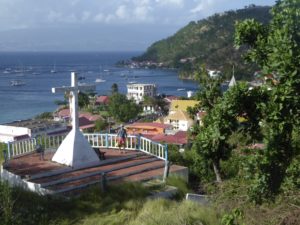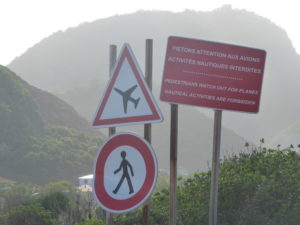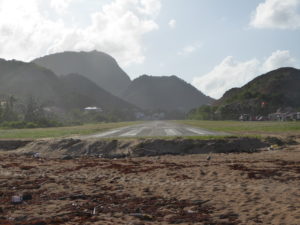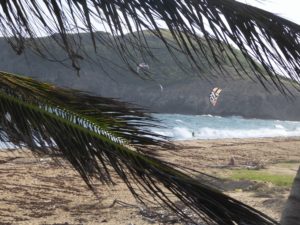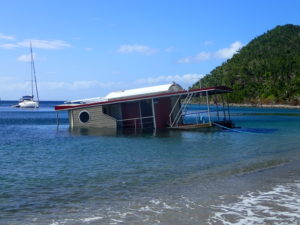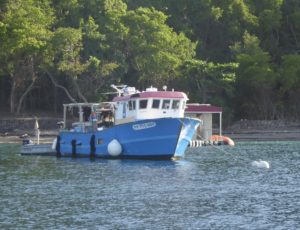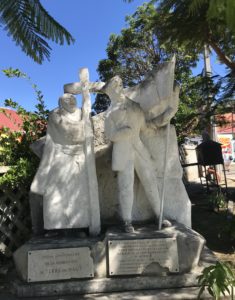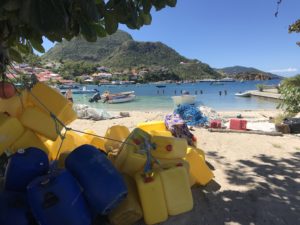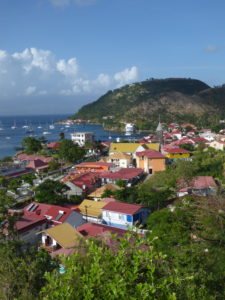If you decide to upgrade your outboard motor at home base, it’s dead easy. Buy the upgraded model and install it on your dinghy. Put the old one on a rack in your garage, post an ad, and await a buyer. You can test it in a bucket of water, or put it onto your dinghy for a test run. When you’re cruising, it’s a slightly different story….
When we arrived in St Martin, we agreed that if we could find a 15 hp 2-stroke outboard engine for our dinghy at a reasonable price, we’d get it. We had such an engine 10 years prior, but sold it when we sold the tender and her mothership. 2-stroke engines are no longer available in the US, but are ubiquitous in the Caribbean. They are significantly smaller and lighter than their counterparts, uncomplicated, and far less susceptible to gunking up with ethanol-laced gasoline (Andy rebuilt the carburetor multiple times last year, in rather inconvenient places).
On the Wednesday before Thanksgiving, we found the engine we wanted, and decided to take the plunge at St Maarten’s Yamaha dealer. St Martin is duty-free, so prices are very reasonable. We planned for a “Black Friday” tank-test and purchase, break it in over the weekend, and set sail for Antigua the following week. The dealer wouldn’t take our 9.9 hp 4-stroke in trade; they said it was too difficult to sell – the same story we got from 3 vendors we approached. Nobody wanted to buy a 4-stroke, or carry one on their inventory. If we didn’t sell the 4-stroke in St Martin, we might have better luck (and more time) in Antigua (where 2-strokes are not sold). So we planned to put the 4-stoke in the 2-stroke box, store it in the aft cabin, and sell it over the next month.
Meanwhile, we posted a few signs at cruisers hang-outs, and posted ads on St Martin Cruisers and Antigua Cruisers’ Facebook Pages, as well as the St Martin equivalent of “Craig’s List”. It was still early season in St Martin, too early for the TimeOutBoatYard nautical flea market, opening 1 Dec when “the season” began. More cruisers would arrive over the next few weeks, but we’d be farther down-island. One broker expressed interest for a client, but the client was adamant about getting a 2-stoke – who could blame him?
Waking up that Friday, we had a change of plan. The 9.9 hp 4-stroke was heavy and awkward, and we realized the folly of trying to sell it out of the aft cabin. Any reasonable buyer would want a test-run. So we watched our new 15 hp 2-stroke engine tank-tested at the Yamaha dealer, then asked them to drain it and pack it back in the box – we would store the new engine until the old engine sold. Then I saw the box… it looked like it might contain a refrigerator! Far too big to fit in the cabin, but the dealer kindly cut it down to a more reasonable size, packed the re-boxed engine onto their large rib, and the followed our dinghy across the lagoon and to our Marigot Bay anchorage. Better yet, they helped us get the box onboard and down the companionway. We had removed all intervening doors, and removed the mattresses and soft goods from the aft cabin to prevent any gas fume contamination.
Attempts to get the boxed engine into the aft cabin failed – it was about ½” too wide, even with the cabin door removed. We couldn’t keep these guys all day, so we hastily asked them to help get the engine out of the box into the cabin, then bring the box back on-deck, where we would re-re-size to fit. We sent them away with a nice tip for their troubles; I think they were very glad to not deal with this any further!
Interior packing was removed, and the box was slightly resized to fit the aft cabin. As you might guess, nobody had looked closely or took photos of how the packing fit into the box, or how the engine fit into the packing. So the engine came back on deck and we did a few trial runs to make it all fit. Next, the box went down below and into the aft cabin. Then the outboard engine – where it eventually fit into the box. Cargo straps bound up the box, and cockpit cushions wedged in to prevent any movement while underway. The engine was remarkably fume-free – the techs had drained it well. I was concerned not only for the smell, but the proximity to the galley, and considered a month of cold food…
Having a new Digicel data plan and good cellular coverage, we decided to spend the next 5 days visiting our favorites in St Martin, while monitoring the onrush of prospective buyers via Facebook. Off we sailed to Tintemarre, Orient Beach, and eventually Grand Case. By Sunday evening, we had 3 prospective buyers lined up in St Martin and Antigua – all through Facebook. We would meet the first prospect, Filipe, on Wednesday in Marigot, since he was off-island until then. Our plan was to depart for Antigua on Thursday – with our without the outboard sale.
While anchored in Grand Case on Tuesday, we had a Facebook message from Louise asking if the engine was still available. I explained that Filipe had first option, but Louise would be next – we were currently in Grand Case, but could meet in Marigot on Wednesday. Louise said they’d be in Grand Case that afternoon. Sure enough, I saw a custom Danish-flagged boat motoring into the harbour (the same boat I saw departing for Marigot that morning) – I messaged Louise to ask if she was on the Danish boat, and she responded yes – could her boyfriend come over to see the engine when they anchored? Certainly! Razmus dinghied over promptly, had a look at the engine, then took her for a test drive around the harbour. A good mechanic, he removed the cover and inspected inside. He said he was certainly interested, and as long as he could get sufficient cash from an ATM that evening, we’d have a deal. Razmus came aboard for a beer, and explained that he and Louise had refit their boat Cortona and sailed it from Denmark to St Martin 3 years ago. He was a carpenter and fully employed on-island, rebuilding after Hurricane Irma. I messaged Filipe to explain the cash contingency, and he was fine with whatever decision was made. Later that evening, Razmus rapped on the hull announcing that he had the cash, and we agreed to make the exchange the next morning.
On Wednesday morning, Andy dinghied over to Cortona, where Razmus, Louise and her visiting sister hoisted it aboard. Razmus towed Andy back to Kinetic (does anyone row?), made the agreed payment, and our deal was made! Next we extracted the new outboard from the aft cabin box and hoisted it onto our dinghy – with a “break-in” spin around the harbor. The box was disassembled yet again, removed from the aft cabin, and loaded into the dinghy. We took it ashore to the recycling bin (French islands are great for recycling!) – Andy disposed of the box while I stayed with the engine – still idling for her break-in period. Meanwhile, I had a conversation with the Mate of the commercial snorkeling boat tied to the same dock, who pointed out his two diesel outboards! I never knew… but now we know the next step!
